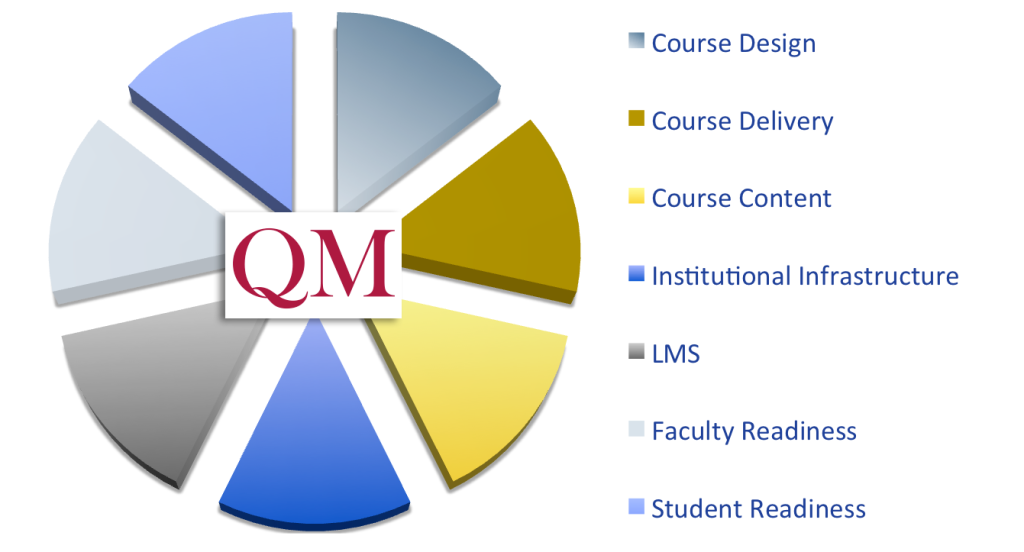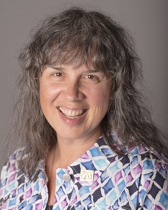Enhancing Quality in Digital Learning
Published by: WCET | 9/9/2021
Published by: WCET | 9/9/2021
WCET’s staff and Steering Committee work groups continue their efforts toward increasing access to quality higher education. Previously our work groups have shared incredible research and discussed opportunities for creating a more equitable and inclusive future for higher education and next up we’ll focus on the ROI of digital learning.
Today we’re highlighting to work from our Steering Committee work group on quality in digital learning. This work is ongoing, but today’s post provides real world examples of how postsecondary instructors and administrators can be involved with quality assurance of course design and programs.
We’re thrilled to welcome several members of the work group who discussed quality in digital learning with WCET staff member Megan Raymond. Megan shared several questions on ensuring quality of teaching and learning, especially as we head back to school this fall, and the future of digital learning in higher education. Thank you to today’s interviewees:
I’d like to extend a special invitation to WCET members to join us for our upcoming WCET Closer Conversation on Ensuring Quality in Digital Learning – September 17, 12:00 pm MDT. During this event members of the WCET Steering Committee quality work group will discuss:
Bring your stories and experiences! Registration is free and open to current WCET members but limited to the first 50 registrations. Participants are invited to interact via video and or chat.
Now, onto our interview with Megan and our interviewees!
-Lindsey Downs, WCET
Brenda Boyd (BB): Instructional and curriculum, continuous quality improvement, and quality assurance.
Gary Chinn (GC): COVID has asked us to confront so many aspects of quality in digital learning, it’s hard to choose a particular one. While we had strong quality guidelines for the creation of digital course materials for fully online courses, we are now looking to build out resources that address quality in hybrid and synchronous remote classes. This expansion in focus does require that we look more closely at the student experience. What does a better Zoom-based learning experience look like? How might we harness the good thinking that has gone into the past 18 months to make lasting changes to our design practice?
Michelle Pacansky-Brock (MPB): Through the lens of achieving educational equity for all humans.
Shannon Riggs (SR): All the above! Providing high-quality online educational experiences is complex and requires quality assurance measures in several areas. Quality Matters has long used the concept of a “quality pie” to explain which aspect of online education their Higher Education Rubric addresses, course design. Other pieces of the pie are important, too, though they are not directly addressed by the QM Rubric: course delivery, course content, institutional infrastructure, the learning management system, faculty readiness, and student readiness.

BB: The most significant concerns about quality in digital learning include the same concerns we have always had about digital learning. The pandemic has amplified and scaled these concerns and shone a spotlight on the lack of comprehensive support provided to online learners that on-ground students have long had available to them. The key concern is to make clear learning promises and to deliver on them, regardless of modality.
GC: Historically in my role, I have primarily been concerned about the quality of the student experience in fully online programs. In that context, it’s both the quality of the program experience, as well as the quality of individual courses, that have been the focal point.
Because of the work we’ve undertaken to help navigate our response to COVID, quality has taken on new aspects. With the emphasis on hybrid models of learning that I expect going forward, the opportunity ahead of us is to build supports for the thoughtful design of learning opportunities that use digital learning tools in the most beneficial ways possible.
MPB: The most significant concern is the paradox that digital learning presents to the increasingly diverse group of students served by higher education. For decades, online and blended courses have increased access to students who have traditionally been left out of higher education. Increasing access to college for students who are low income, first generation, Black, Hispanic, and other students of color is something to celebrate. But we also know that these same students are less likely to succeed in online courses than their White and Asian peers.
SR: Right now, my main concern is that students, faculty, and administrators might not understand that the emergency remote education is not the same as “traditional” online education – that is, online courses and programs that were intentionally and methodically designed to be delivered in an online format.
What faculty have been able to do with remote instruction during the pandemic has been remarkable. What a feat to pivot to a new way of teaching in such a short and stressful time. At Oregon State, we have heard many times through the pandemic that our faculty who had training and experience in online course design and delivery had a much easier time shifting their campus-based classes to remote courses. However, I’m sure that nation-wide, many faculty who did not have that training and experience struggled.
On the flip side of that concern, though, is a lot of excitement and hope. This is a very exciting time to be working in online education. Experienced online educators are poised to serve as leaders to all who work in higher education right now. Online educators, administrators, instructional designers, and faculty development professionals know a lot about how to design and deliver high-quality online education. Once we move into a post-pandemic era in higher education, it is likely that students will seek the flexibility that blended and online education afford and those more experienced online education leaders can share what they know.
BB: Providing professional development for faculty and staff to help support learners across modalities is a major opportunity area. Faculty who never anticipated teaching online are doing so now or have pivoted from emergency remote instruction toward online learning that is more organized and thoughtful. Instructional designers have been amazing allies and supports throughout the pandemic to help faculty learn to use technologies for teaching and how best to leverage them, if faculty did not know already.
No matter where a campus is in terms of their evolution in digital learning, there is always room to improve. If campuses are already on the pathway to continuous improvement, the opportunities that come from that investment include growing programs, increasing enrollments, and improving the student experience. Institutional leadership supporting what works well across the institution is another area of opportunity. Willingness to change and use a growth mindset to learn from this experience and pivot to providing students with quality learning experiences through faculty and staff development will be critical during this time of many models and flexible pathways for student success.
Learner support services and initiatives were highlighted as major drivers of student success in the recent QM President’s Summit report. Through making services and supports available to students in digital environments, all students are helped. How to provide learner and academic support at scale is a big opportunity area for institutions.
GC: I believe that the opportunity we have collectively for improving digital learning is the creation of a more flexible and coherent student experience. Can we marshal the ideas, technologies, and institutional will to create reliable and varied pathways for our learners? This runs the gamut from individual courses through full programs. A quality lens plays an essential role in this transformation because our students will benefit most from learning designs, policies, and supports that are consistent and advance their educational experiences.

MPB: Too often, educators (which I use as an inclusive term for all faculty, staff, and administrators) approach quality through the lens of equality, as opposed to equity. Equality implies that it is fair to treat everyone the same. But we know everyone is not the same. An equity lens enables us to see that each student brings unique needs, and our learning and support environments must be responsive in order to be high-quality and meet those needs to ensure all students can succeed.
A great opportunity for improving quality lies in creating institutional cultures that value teaching. Course design rubrics serve a valuable role for faculty but course design is just one side of the coin. Teaching is the other side. In the past ten years, course design rubrics have gained significant traction in quality efforts in online education across the United States. And that work has been important. I can remember when I first saw a course design rubric a few years after I started teaching online. I made really valuable changes to my course, as a result.
But a well-designed course doesn’t translate directly into a meaningful online learning experience that supports the needs of our diverse students. The quality of faculty-student interactions is critical to building trust and motivation in digital learning environments. Cultivating positive instructor-student relationships is a huge opportunity for advancing equity in high-quality digital learning environments. And the moment is ripe for this. Human connection is revitalizing, particularly when a person feels depleted and burned out.
SR: One of the challenges we faced during the pandemic was with exam proctoring. The inability to proctor exams in person was a significant hurdle. Online proctoring helped in many cases, but there are still some concerns about student privacy. To my mind, this means that we have some opportunity to improve our approach to assessment in digital learning.
Peer review tools seem especially promising – they foster active learning and critical thinking while also keeping the grading burden on faculty reasonable. Who doesn’t want rigorous assessment options that aren’t prohibitive workload-wise? Some faculty may have qualms about relinquishing grading to a peer review system, because providing feedback is so much a part of their identity as an educator. The research on these systems is very promising and I believe that once faculty understand how critical their input is in the design process of an assignment using a tool like this, and that they can override a grade in the rare cases when something goes awry, that they may be more open to using these kinds of tools.
BB: What’s top of mind is how administration and faculty support must be in place to support students as they enter a precarious and uncertain academic year. How is the institution committing to supporting quality teaching and learning through faculty support and student support? Providing these crucial services at scale challenges the most committed institution because it is the culture of the institution that may need to pivot now to support learning. Culture eats strategy for breakfast, so said Peter Drucker, so institutions will need to align their strategies with their institutional cultures to drive successful change.
GC: For this fall, what is top of mind for me is broadly the professional development aspect. How can we support instructors who might be experiencing new teaching modalities, new tools, and very unpredictable environments? What do they need most right now? How can they hear from students in a way that might benefit teaching practice? How do we introduce instructors to tools that may be of benefit, while being mindful not to overwhelm people who are navigating a very stressful experience? So, a collaborative strategy for the provision of guidance and tools is part of what’s on my mind this fall.
MPB: We need to shift mindsets about online courses and misperceptions about quality. One thing we can do more of is locating bright spots from the past year and a half – and you must believe that there are bright spots. Have faculty at your institution been given the opportunity to share why they love teaching online? Or share something they are proud of about their course? Create a stage for these examples and be sure to cast a wide net to include a diverse array of faculty in your efforts.
From my experiences working with and supporting educators who teach at a distance, online professional development can also shift mindsets about online courses. When an educator participates in an online program facilitated by an engaged, empathetic instructor with high expectations, they begin to comprehend how relationships can be developed at a distance and fuel intrinsic motivation. Faculty want to be proud of their courses. If they haven’t experienced an online learning experience that inspires them, how will they see that high-quality online teaching can be transformative? And if they don’t have the digital fluency to use technologies beyond a learning management system, then we aren’t serving them as we should.
SR: Top of mind for me heading into fall is investing in the continual improvement of mature online programs at Oregon State, in addition to developing exciting new online programs. I am especially interested in exploring standards for online program quality that will help us set stretch goals for improving our students’ educational experiences and collaborate with academic partners using a common language around online program management.
GC: I think it’s been a plus to have an established quality assurance design standards for digital learning experiences. These standards have been around for years, and address aspects like accessibility, orientation, learning activities, assessments, and student feedback for course improvements. While the standards were built with fully online courses in mind, the framework was a great starting place when supporting large-scale remote teaching. One positive outcome of all we’ve learned might be that more institutions could establish their own quality standards. We’ve all learned so much that could benefit a resource like that.

BB: My best advice is to define a measurable goal and work toward it incrementally. A commitment to continuous improvement with incremental change is a path that everyone can follow. Save big changes for when there are blocks of time to devote to redesign or work in parallel. Have a goal and work toward it in small ways regularly.
MPB: As institutions move forward with Diversity-Equity-Inclusion (DEI) efforts, we must recognize that each of us plays a role in creating a more inclusive and equitable future for all.
SR: One strategy I am especially excited would be the Oregon State Ecampus Online Teaching Principles. These research-based principles help faculty new to online education appreciate what good online teaching looks like, and help experienced faculty reflect on their teaching practice. As a Quality Matters institution, we felt we had a strong foundation for online course design, but we felt there was a need for a tool that could paint a picture of what good online teaching looks like, after the design work is completed. We made our teaching principles openly available under a Creative Commons license to help fill that gap for other institutions that felt the need to better support online teaching.
BB: Every institution and their faculty and staff are in a different place with their efforts toward quality. Getting the right people at the table to implement any kind of quality assurance plan is the first step. The next step is defining goals. What is important to administrators may not be the same things that are important to faculty, so those conversations are crucial to coming to common goals that enable everyone to achieve them. When those goals are not met, what supports are in place to enable continuous improvement?
Lastly, I know that Every Learner Everywhere has put out resources including the Playbooks that are very helpful for online course planning and helping faculty do incremental changes to their courses. QM has also provided the Bridge to Quality: An Online Course Design Guide that is free to everyone. It is designed as “an instructional designer at your elbow” for those who don’t have instructional design resources available to them at their campus to help them move online in an intentional and quality way. The design process is aligned to QM Standards and helps faculty ensure they include important things in their courses such as institutional policies and links to support services for students.
SR: The pandemic and the need to provide instruction remotely has pushed higher education to be more student-centric in how we deliver education. I believe that students will now (rightfully) expect a student-centered approach to continue. Experienced online educators know a lot about delivering education in a student-centered manner and have much to offer higher ed in leading us to more student-centered ways of doing business. There’s never been a more exciting time to be working in online, blended, and digital education.
Thank you again to our wonderful interviewees and interviewer for today’s discussion. Remember to register now for our WCET member-only Closer Conversation on quality in digital learning, September 17, 12:00 pm MDT!



